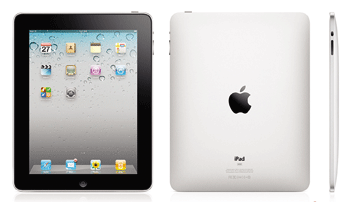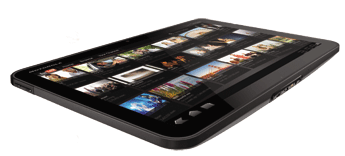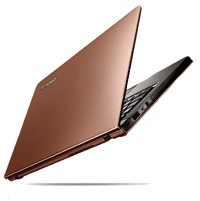For the nimble business traveler, lighter and smaller is always better. And if you can add function, style and coolness, even better. So, it's easy to understand the excitement for the new wave of tablet computers. Apple's iPad currently accounts for about 80 percent of the market, but that could soon change following a bevy of new products that were rolled out at the recent Consumer Electronics Show. Below are three options worth considering. iPadwww.apple.com/ipadThere's a reason why the iPad dominates the market, in fact there are 300,000 reasons, and growing. The single biggest differentiator for the iPad is Apple's app store, which is larger and more comprehensive than its competitors. The device itself is still the industry standard, but others are catching up quickly. Look for the second generation iPad, due in early 2011, to try to distance itself from its latest competition. The upgrades in the new version are still in the rumor stage, but based on iPad2 cases that have already leaked, it seems likely that there will be a front camera to enable video conferencing.
iPadwww.apple.com/ipadThere's a reason why the iPad dominates the market, in fact there are 300,000 reasons, and growing. The single biggest differentiator for the iPad is Apple's app store, which is larger and more comprehensive than its competitors. The device itself is still the industry standard, but others are catching up quickly. Look for the second generation iPad, due in early 2011, to try to distance itself from its latest competition. The upgrades in the new version are still in the rumor stage, but based on iPad2 cases that have already leaked, it seems likely that there will be a front camera to enable video conferencing.
 Xoomwww.motorola.com/xoomWhile the Xoom isn't yet available for purchase, that hasn't stopped several tech blogs from hyping Motorola's new tablet as the next iPad killer. The device itself stands up nicely: the screen is a little bigger (10.1 inches vs. iPad's 9.7), the processor is faster (1GB vs. iPad's 16GHz processor and 256MB of RAM). And the Xoom has two distinct advantages: 1) Unlike the iPad, the Xoom supports Adobe Flash, which allows users to view all Websites the way you would from a traditional laptop/desktop; 2) The Xoom is built on a Google-based operating system that was specifically designed for tablets, which allows it to work with third-party applications. The Apple app store still has about three times as many apps, but Google's Android Market is gaining ground. In March 2010, it was estimated that there were about 30,000 Android apps; that number jumped to about 100,000 by December.
Xoomwww.motorola.com/xoomWhile the Xoom isn't yet available for purchase, that hasn't stopped several tech blogs from hyping Motorola's new tablet as the next iPad killer. The device itself stands up nicely: the screen is a little bigger (10.1 inches vs. iPad's 9.7), the processor is faster (1GB vs. iPad's 16GHz processor and 256MB of RAM). And the Xoom has two distinct advantages: 1) Unlike the iPad, the Xoom supports Adobe Flash, which allows users to view all Websites the way you would from a traditional laptop/desktop; 2) The Xoom is built on a Google-based operating system that was specifically designed for tablets, which allows it to work with third-party applications. The Apple app store still has about three times as many apps, but Google's Android Market is gaining ground. In March 2010, it was estimated that there were about 30,000 Android apps; that number jumped to about 100,000 by December.  IdeaPad UIwww.lenovo.comThe star of last year's Consumer Electronics Show has a new entry for 2011 that combines the best of a tablet and a laptop. The so-called hybrid laptop offers a docking station that looks like a laptop with an empty shell where the screen would normally be, but actually houses its own processor. The tablet can operate by itself or be added to the docking station and work like a laptop, giving it extended battery life, a full-sized keyboard, and access to USB and HDMI out ports. When operating separately as a tablet, it uses the Android operating system, which is expected to be upgraded to the same version used by the Xoom, and has a 1.3 GHz processor. When docked, it seamlessly switches to Windows 7. The IdeaPad U1 is not yet available in the U.S., but is expected to be available in China in the first quarter of 2011. The tablet will sell for the equivalent of about $520 and the tablet and docking station combined will sell for about $1,300.
IdeaPad UIwww.lenovo.comThe star of last year's Consumer Electronics Show has a new entry for 2011 that combines the best of a tablet and a laptop. The so-called hybrid laptop offers a docking station that looks like a laptop with an empty shell where the screen would normally be, but actually houses its own processor. The tablet can operate by itself or be added to the docking station and work like a laptop, giving it extended battery life, a full-sized keyboard, and access to USB and HDMI out ports. When operating separately as a tablet, it uses the Android operating system, which is expected to be upgraded to the same version used by the Xoom, and has a 1.3 GHz processor. When docked, it seamlessly switches to Windows 7. The IdeaPad U1 is not yet available in the U.S., but is expected to be available in China in the first quarter of 2011. The tablet will sell for the equivalent of about $520 and the tablet and docking station combined will sell for about $1,300.
There is no shortage of other tablet computers in the marketplace.Below are four other Windows 7-based options:
To continue reading, become an ALM digital reader
Benefits include:
- Authoritative and broad coverage of the business of consulting
- Industry-leading awards programs like Best Firms to Work For, Global Leades and Rising Stars
- An informative newsletter that goes into the trends shaping the industry
- Critical coverage of the employee benefits and financial advisory markets on our other ALM sites, BenefitsPRO and ThinkAdvisor
Already have an account? Sign In Now

